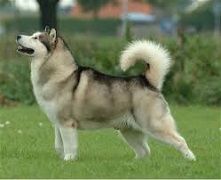
The Inuit Mahlemut, a nomadic people, used this dog to help them move large freight and pull heavy loads an activity in which speed was not the point. Generation after generation, the Alaskan Malamutes developed as dogs used to work in packs alongside their masters.
The Alaskan Malamute reaches 25 inches (64 cm) and 85 pounds (39 kg) as a male dog and 23 inches (58 cm) and 75 pounds (34 kg) as a female. Some breeders also tried to obtain and are now selling much larger Malamutes, but they are prone to orthopedic problems, because of their unnatural size. The standard Malamutes vary in color from gray to black and red, all combined with white, or are simply white altogether. If you want a genuine Malamute, its eyes should be brown. Alaskan Malamutes with blue eyes are disqualified from competitions, as they are not considered purebred.
There is only one study available about the Malamutes life expectancy, concluding that the normal life span of this dog is 10 years.
A rather controversial thing about the Alaskan Malamute is its intelligence. At a shallow look, an owner who does not understand the mindset of this dog will more often than not conclude that the breed is not that smart. The truth is that the dog is quite intelligent, active and with a huge instinct to protect its master. Do not mistake its independence for stupidity! You can often hear stories about Alaskan Malamutes who, at some point, refused to take orders from their musher and chose to take a certain route just to prove, later on, that the route their musher had picked was on a too thin ice, which would have ended in disaster. Sometimes, Alaskan Malamutes manage to pull the sleigh home even when their musher has lost any hope.
The owners of this breed should first read and understand the dog, its history, the way its ancestors related to their masters, its needs and behavior, and then go on and take one or two dogs home. This breed does not answer to violence, nor will it do what you want unless you assert yourself as the alpha in the pack. Training an Alaskan Malamute is not done over night, as the relationship with it takes time and patience to build.
Once you understand that some of the ancestors of the Alaskan Malamute are wolves (which can be easily noticed by the way it howls) and that its natural instincts need to be stimulated for the better, you can get along well with it and be the happy master of a quite unique dog.




